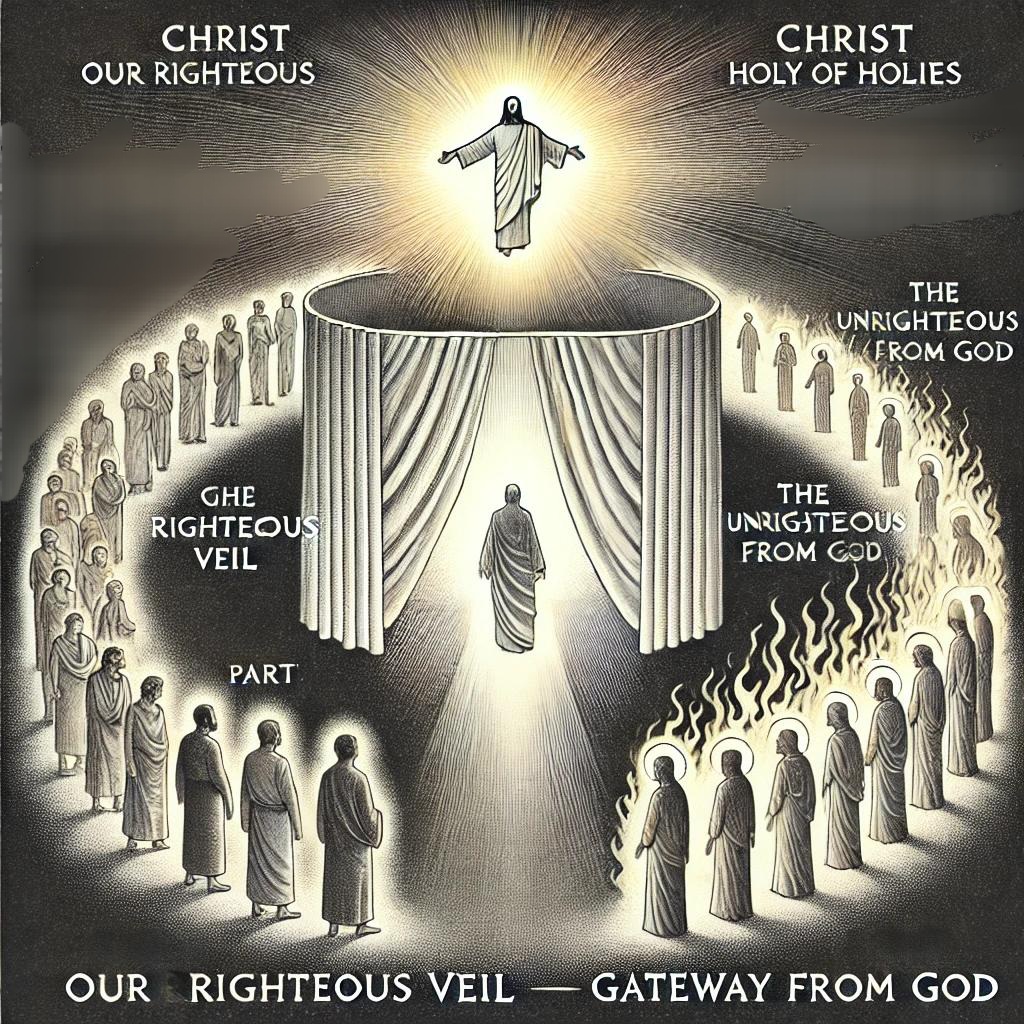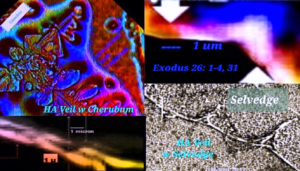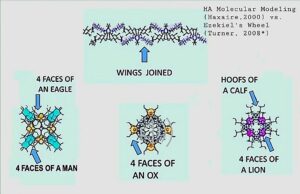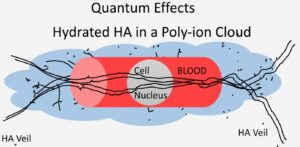White Paper
Our Hyaluronic Acid Quantum Veil and Its Implications
Executive Summary
This white paper presents a groundbreaking discovery that bridges the fields of molecular biology and theology: the identification of hyaluronic acid (HA) as the molecular patterning of the Hebrew tabernacle (temple) veil. This capstone discovery, made through detailed comparisons of biblical descriptions and contemporary molecular structures, has profound implications for our understanding of human identity and our place in the cosmos. HA, a ubiquitous molecule in living creatures, mirrors the intricate patterning of the temple veil as described by Moses (1300 BCE) and confirmed by Ezekiel (600 BCE).

As the temple of God, our spirit-soul anchored in the material dimension forms a quantum bridge to the spiritual dimension. Boundary conditions and selection rules for spirit-souls after physical death are set by our Righteous Redeemer.
Introduction
Theobiology is an emerging interdisciplinary field that seeks to understand the intersection between theology and biology. At its core, theobiology explores how ancient scriptures and modern scientific discoveries can illuminate our understanding of the human condition and our relationship with the divine. This white paper focuses on a pivotal discovery within this field: the molecular patterning of hyaluronic acid as analogous to the Hebrew temple veil described by Moses and Ezekiel. With numerous examples given in scripture, we can be sure that as the temple of God, the temple veil design described by Moses (Exodus 26) is patterned after the veil within us as the image of God (Ezekiel 1). The resonance between our material selves and our spiritual destiny most likely involves a quantum bridge.
The Discovery
Hyaluronic acid (HA) is a naturally occurring molecule known for its structural and functional roles in the biomatrix engineering of living creatures. If we, as living souls, were like books, DNA would contain the information, and HA would be its cover. Our research has uncovered striking similarities between the molecular structures of HA and the detailed descriptions of the temple veil found in biblical texts. By employing modern scientific methodologies, this author took previously published molecular modeling data on double-helical HA and compared those data with his hands-on analysis of HA nanoscale patterning using “state of the art” surface probing tools. Detailed descriptions of the Hebrew tabernacle veil were given by Moses, while the living veil from heaven was described by Ezekiel as Ezekiel’s wheel.
Methodology
The research involved a comparative analysis of the descriptions of the temple veil in the books of Exodus and Ezekiel with the molecular structures of HA. Advanced imaging techniques and molecular modeling were used to identify the self-assembling patterns of HA fragments, which were then compared to the biblical accounts. The findings revealed remarkable parallels suggesting a deeper symbolic and biological connection.
Results
 Figure 1. The surface properties of hyaluronic acid (HA) as described in Exodus 26 were examined and found to be consistent with those determined in the laboratory. The author conducted numerous experiments on HA fragments during dehydration, which were analyzed at the Center for Materials Science and Engineering at MIT. The analytical instruments used included Scanning Electron Microscopy (SEM), Tandem Electron Microscopy, Tapping Mode-Atomic Force Microscopy (AFM), Spin Dipping PEML, LEXT 3D Laser Confocal Microscopy, Electrospray and Electrospinning, Fourier-transform Infrared Spectroscopy (FTIR), UV/IR Spectroscopy, Cell Culture, and Phase Contrast Microscopy. The results, including hydro-images, confirm HA’s role as the body’s temple veil.
Figure 1. The surface properties of hyaluronic acid (HA) as described in Exodus 26 were examined and found to be consistent with those determined in the laboratory. The author conducted numerous experiments on HA fragments during dehydration, which were analyzed at the Center for Materials Science and Engineering at MIT. The analytical instruments used included Scanning Electron Microscopy (SEM), Tandem Electron Microscopy, Tapping Mode-Atomic Force Microscopy (AFM), Spin Dipping PEML, LEXT 3D Laser Confocal Microscopy, Electrospray and Electrospinning, Fourier-transform Infrared Spectroscopy (FTIR), UV/IR Spectroscopy, Cell Culture, and Phase Contrast Microscopy. The results, including hydro-images, confirm HA’s role as the body’s temple veil.
 Figure 2. The molecular modeling (Haxaire et al. 2000) is strategically colored to illustrate the description of the veil given by Ezekiel in Chapter 2 of the Book of Ezekiel. In every detail, we observe agreement between the molecular model and Ezekiel’s prophetic vision from over 2600 years ago. This finding has far-reaching implications. How could the sophisticated analytical tools used at MIT validate Ezekiel’s description unless the Creator who exists outside of time revealed this reality to him?
Figure 2. The molecular modeling (Haxaire et al. 2000) is strategically colored to illustrate the description of the veil given by Ezekiel in Chapter 2 of the Book of Ezekiel. In every detail, we observe agreement between the molecular model and Ezekiel’s prophetic vision from over 2600 years ago. This finding has far-reaching implications. How could the sophisticated analytical tools used at MIT validate Ezekiel’s description unless the Creator who exists outside of time revealed this reality to him?
 Figure 3. The quantum properties of the hyaluronic acid (HA) nanoscale fibrous network form a systemic cloaking device within us. This ‘temple’ veil, patterned after the Hebrew temple veil made by human hands, suggests that the Spirit now dwells within us, creating a superior tabernacle. Just as the perfect temple was destroyed and raised from the dead, we too will be raised. Believers are entangled, coherent, and one in Christ. Our Spirit-Soul will be united with our Creator by tunneling through our Quantum Veil.
Figure 3. The quantum properties of the hyaluronic acid (HA) nanoscale fibrous network form a systemic cloaking device within us. This ‘temple’ veil, patterned after the Hebrew temple veil made by human hands, suggests that the Spirit now dwells within us, creating a superior tabernacle. Just as the perfect temple was destroyed and raised from the dead, we too will be raised. Believers are entangled, coherent, and one in Christ. Our Spirit-Soul will be united with our Creator by tunneling through our Quantum Veil.
Implications
- Human Identity as Divine Temples: The discovery that HA mirrors the temple veil supports the biblical assertion that humans are made in the image of God and are temples of the Holy Spirit. This provides a tangible and testable framework that bridges faith and empirical science.
- Integration of Faith and Science: This research invites a reevaluation of ancient texts through contemporary scientific perspectives, fostering an interdisciplinary approach that seeks to integrate biblical insights with molecular biology. This new paradigm challenges the skepticism often associated with the Gospel in the scientific community and opens the door for collaborative exploration.
- Quantum Biology and Spirituality: The concept of a quantumized veil formed by HA suggests that our biological structures may serve as a bridge between the physical and spiritual realms. This has far-reaching implications for our understanding of consciousness, spirituality, and human life.
- Theological and Scientific Dialogue: This discovery encourages ongoing dialogue between theologians and scientists, promoting mutual respect and understanding. By demonstrating that divinely inspired scriptures can align with modern scientific findings, this research underscores the value of interdisciplinary collaboration.
Conclusion
The identification of hyaluronic acid as the molecular patterning of the Hebrew temple veil represents a significant milestone in the field of theobiology. This discovery not only enriches our understanding of human identity and our place in the cosmos but also highlights the potential for a harmonious integration of faith and science. As we continue to explore the intersections between ancient wisdom and contemporary scientific discoveries, we move closer to a holistic understanding of who we are and our eternal destiny.
References
- Theobiology.com
- Moses: Exodus Chapter 26
- Ezekiel: Ezekiel Chapter 1
- Various scientific articles on hyaluronic acid and its molecular structures. Compare with front page AI generated image.

- HaShem Veil E-Book